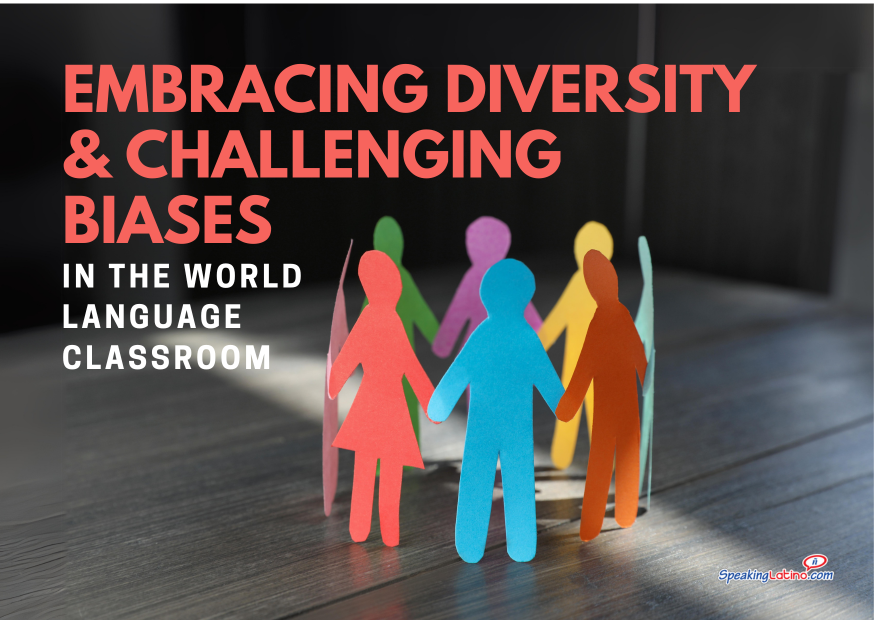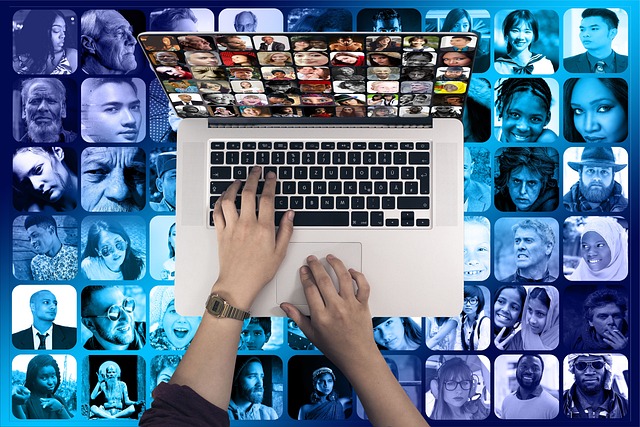
The content of this article is based on the presentation, First Steps in the Work on Equity in the Language Classroom by Adriana Ramírez, which was part of the World Language Teacher Summit.
A Path to Equity: Transforming the Language Classroom
In an increasingly diverse and interconnected world, the language classroom has become a critical arena for promoting equity and challenging biases. This has necessitated a shift in pedagogical approaches to ensure that teaching methods are inclusive and reflective of the complexities of gender, race, and culture. Recognizing personal biases, addressing systemic inequities, and celebrating linguistic diversity are foundational steps toward achieving this goal.
Recognizing and Addressing Biases: Unveiling the Layers of Bias in Education
Before any meaningful work can be done to foster equity in the classroom, it is essential to recognize and confront the biases entrenched in the educational system and within educators themselves. Biases, whether implicit or explicit, can profoundly impact teaching and learning experiences. Both the system and individual lenses are filters through which educational content is both viewed and presented. By identifying these biases, educators can begin to dismantle the prejudices that hinder the development of an inclusive classroom environment.
Utilizing Media to Challenge Preconceptions
Language educators have unique tools at their disposal, such as picture talks, movie talks, and classroom discussions conducted entirely in the target language, to bring issues of gender stereotypes and racial biases into the forefront of student awareness. These methods allow for the critical analysis of content and provide opportunities for students to challenge societal norms and the status quo. By critically engaging with literature and media, students become agents of change, questioning and reshaping the narratives they are exposed to.
Creating Representation through Literature
The creation of a book collection such as Revolucionarias opens a window into the inspiring lives of real women from Latin America, directly confronting gender stereotypes and offering alternative role models. Featuring stories that diverge from conventional narratives provides students with a broader perspective on the diverse tapestry of human experiences. This approach promotes an understanding of the significance of representation in literature and encourages students to seek out and value diverse voices.
Fostering Critical Thinking Through Guided Inquiry
Educators have a responsibility to guide their students in becoming critical thinkers about biases. A set of well-crafted questions, along with strategically designed posters, can help steer readings, movie viewings, and discussions towards a deeper understanding of the content. This pedagogical strategy equips students with analytical tools to navigate and critique the media they consume, encouraging a persistent inquiry into the underlying messages conveyed.
Celebrating Multilingual Voices
The embrace of translingualism in the classroom not only recognizes the linguistic repertoire of students but also celebrates it. Instead of viewing students' diverse language backgrounds as challenges to be overcome, this approach treats them as assets that enrich the entire learning community. By valuing the spectrum of languages present in the classroom, educators can foster an inclusive environment that respects and promotes cultural and linguistic diversity.
The Path to Anti-Racist Teaching
Reflection on one's cultural lens is a pivotal first step toward the creation of an anti-racist classroom. This involves an awareness of the cultural, historical, and social factors that influence individual perspectives. Utilizing tools such as the wheel of privilege, educators and students can explore the many layers of intersectionality that define their identities. Engaging in these reflections is crucial in understanding the dynamics of power and privilege that operate within educational spaces.
The Responsibility of Privilege in Education
With an understanding of their cultural lenses and positionalities, individuals can use their privileges to challenge existing inequities. Privilege in various forms—be it racial, gender, or socio-economic—carries weight in societal structures, including education. When those with privilege actively seek to dismantle the systems that grant them unearned advantages, they contribute to the creation of a more just and equitable society.
Using Social Media and Other Resources for Education
In the digital age, educators can tap into an array of resources such as social media platforms, websites, and online marketplaces to access diverse content and pedagogical tools. These platforms can be used to share resources and engage with broader conversations about decolonizing language classrooms and incorporating diverse narratives. By leveraging these tools, educators can stay updated on the latest developments in equity-focused education and continue to refine their teaching practices.
Incorporating Nonbinary Language and Expanding Boundaries
The traditional binary language system often fails to represent the experiences of those who identify beyond binary genders. Educators can play a vital role in introducing nonbinary language into the classroom to reflect a broader spectrum of gender identities. In doing so, language instruction goes beyond grammar and vocabulary, venturing into the realms of social justice and inclusivity.

Biases can profoundly impact teaching and learning experiences.
The Imperative of Representation and Own Voices Literature
The use of own voices literature, where authors write from their own cultural and experiential perspectives, is a crucial component in addressing biases and promoting equity. It ensures that stories are not filtered through an external lens, but rather presented in their authentic voice. This literary approach contributes to a more accurate and respectful representation of diverse experiences in the classroom.
Embracing Discomfort and Taking Action: The Courage to Challenge and Change
Achieving equity in the language classroom is not without its challenges. It requires a willingness to reflect on discomforting truths, acknowledge structural inequalities, and take decisive action to address them. Educators are encouraged to engage in critical self-reflection, confront their discomfort, and adopt a proactive stance towards creating change. This involves a committed effort to re-evaluate existing curricula, teaching methods, and educational resources.
FAQs About Equity in the Language Classroom
What practical tools are recommended for promoting equity in the language classroom?
Some practical tools recommended for promoting equity in the language classroom include:
- Reflecting on one's cultural lens and understanding how it influences teaching practices.
- Engaging in conversations with colleagues to share perspectives and insights.
- Educating oneself on issues of equity, diversity, and inclusion.
- Incorporating diverse literature and resources that represent a variety of voices and experiences.
- Using guiding questions and discussions to challenge stereotypes and biases in readings and media.
- Creating a safe space for students to explore their own cultural backgrounds and perspectives.
- Encouraging critical thinking and reflection on societal norms and power dynamics.
- Implementing activities that promote cultural appreciation and understanding.
- Providing opportunities for students to recognize and address biases within themselves and the broader society.
- Emphasizing the importance of language as a tool for social justice and empowerment.
How is diversity and cultural appreciation incorporated into language teaching methods?
Diversity and cultural appreciation are incorporated into language teaching methods by:
- Using diverse and authentic materials: Including literature, media, and resources from various cultures and backgrounds to expose students to different perspectives and experiences.
- Celebrating linguistic diversity: Acknowledging and valuing the languages spoken by students in the classroom, encouraging them to share their language skills and cultural knowledge.
- Promoting cultural exchanges: Organizing activities that allow students to share their cultural traditions, practices, and beliefs with their peers, fostering mutual understanding and respect.
- Incorporating cultural themes: Integrating cultural topics, such as traditions, customs, history, and current events, into language lessons to provide a broader context for language learning.
- Encouraging critical thinking: Prompting students to analyze and reflect on cultural stereotypes, biases, and power dynamics present in language and society.
- Providing opportunities for language immersion: Creating authentic language experiences through interactions with native speakers, cultural events, and immersive activities to enhance language learning and cultural understanding.
- Emphasizing empathy and open-mindedness: Encouraging students to approach language learning with curiosity, empathy, and a willingness to engage with diverse perspectives and experiences.
By incorporating these strategies, language teachers can create inclusive and culturally rich learning environments that promote diversity, equity, and cultural appreciation among students.

Language educators have unique tools at their disposal to bring issues of gender stereotypes and racial biases into the forefront of student awareness.
How can teachers embrace cultural diversity and challenge stereotypes in their classrooms?
Teachers can embrace cultural diversity and challenge stereotypes in their classrooms by:
- Creating a culturally inclusive environment: Establishing a classroom culture that values and respects diverse backgrounds, languages, and perspectives.
- Incorporating diverse perspectives: Introducing literature, media, and resources that represent a variety of cultures and voices to broaden students' understanding of the world.
- Encouraging open dialogue: Facilitating discussions on cultural topics, stereotypes, and biases to promote critical thinking and reflection among students.
- Providing opportunities for cultural exchange: Organizing activities that allow students to share their own cultural traditions, languages, and experiences with their peers.
- Addressing stereotypes directly: Challenging misconceptions and stereotypes through education, discussion, and exposure to diverse perspectives.
- Promoting empathy and understanding: Encouraging students to empathize with others' experiences, perspectives, and challenges to foster a sense of cultural sensitivity and awareness.
- Celebrating cultural heritage: Recognizing and celebrating cultural holidays, traditions, and events from various backgrounds to promote inclusivity and appreciation for diversity.
- Modeling inclusive behavior: Demonstrating respect for all students' backgrounds, languages, and identities to create a welcoming and supportive learning environment.
By actively embracing cultural diversity and challenging stereotypes in the classroom, teachers can create a more inclusive, respectful, and enriching educational experience for all students.
Equity in Language Education: Nurturing Growth and Social Change Through Cultural Celebration
True equity in the language classroom is an ongoing pursuit, requiring continuous effort, self-reflection, and a commitment to change. By recognizing and addressing biases, celebrating diversity in language and culture, and leveraging resources for education, educators can cultivate an environment where every student has the opportunity to learn, grow, and flourish. It is through these steps that language learning can transcend the acquisition of linguistic skills and become a powerful vehicle for equity and social change.